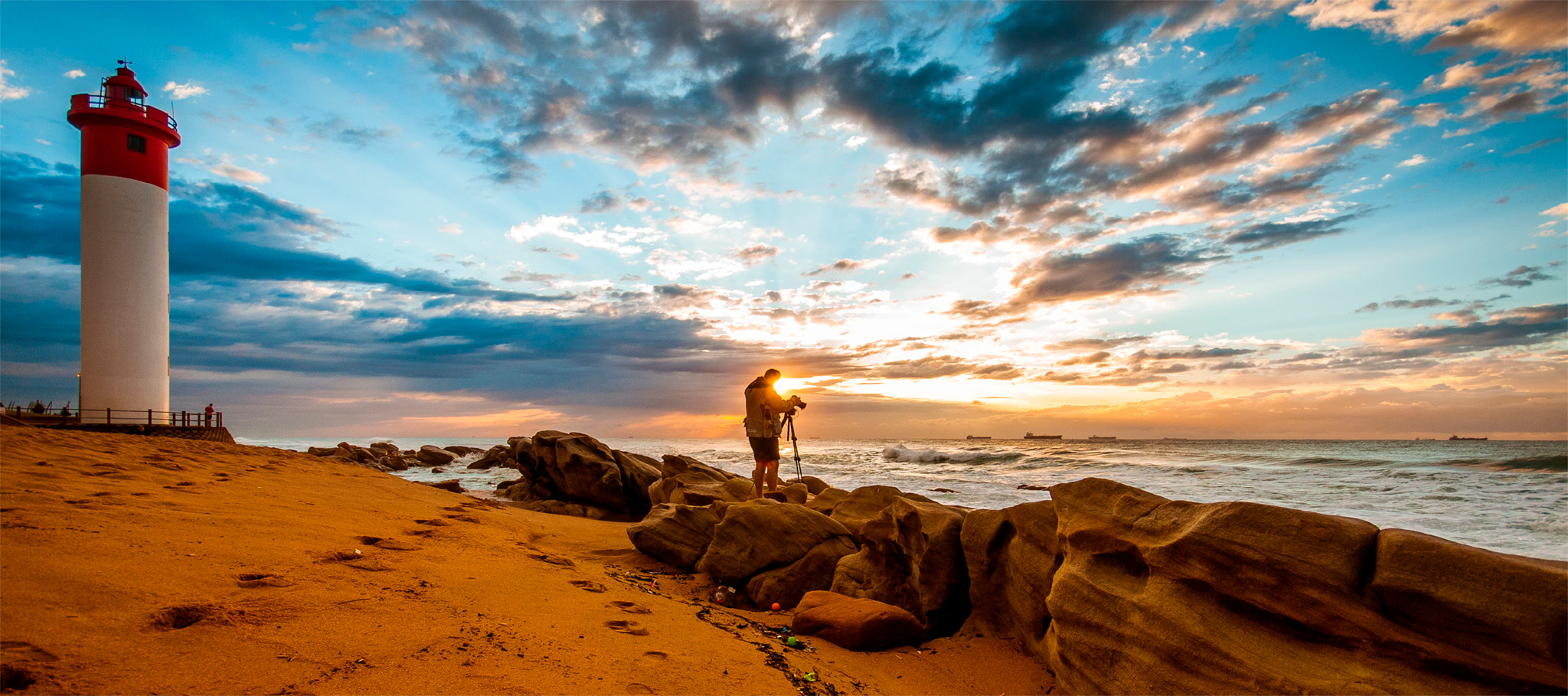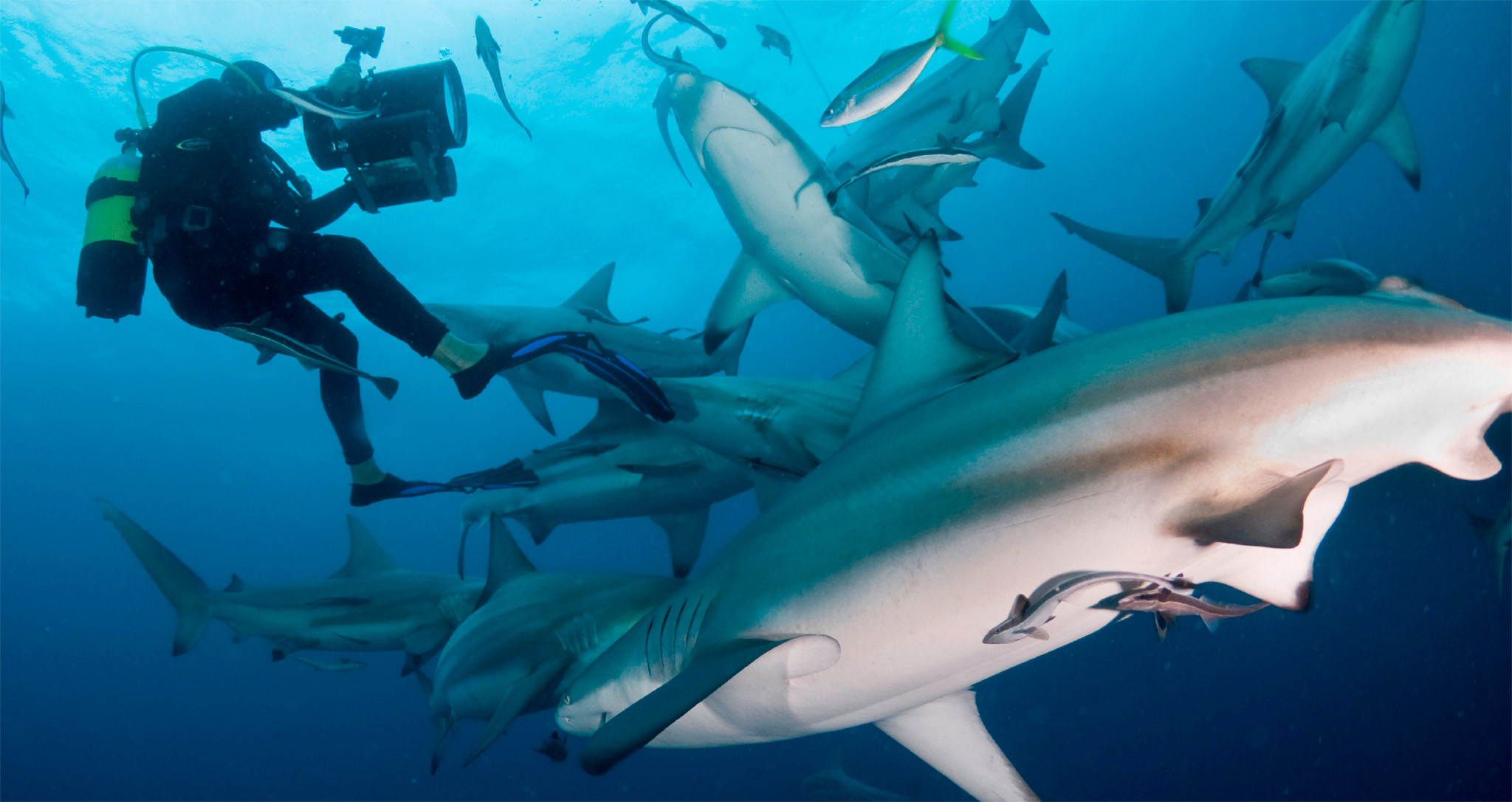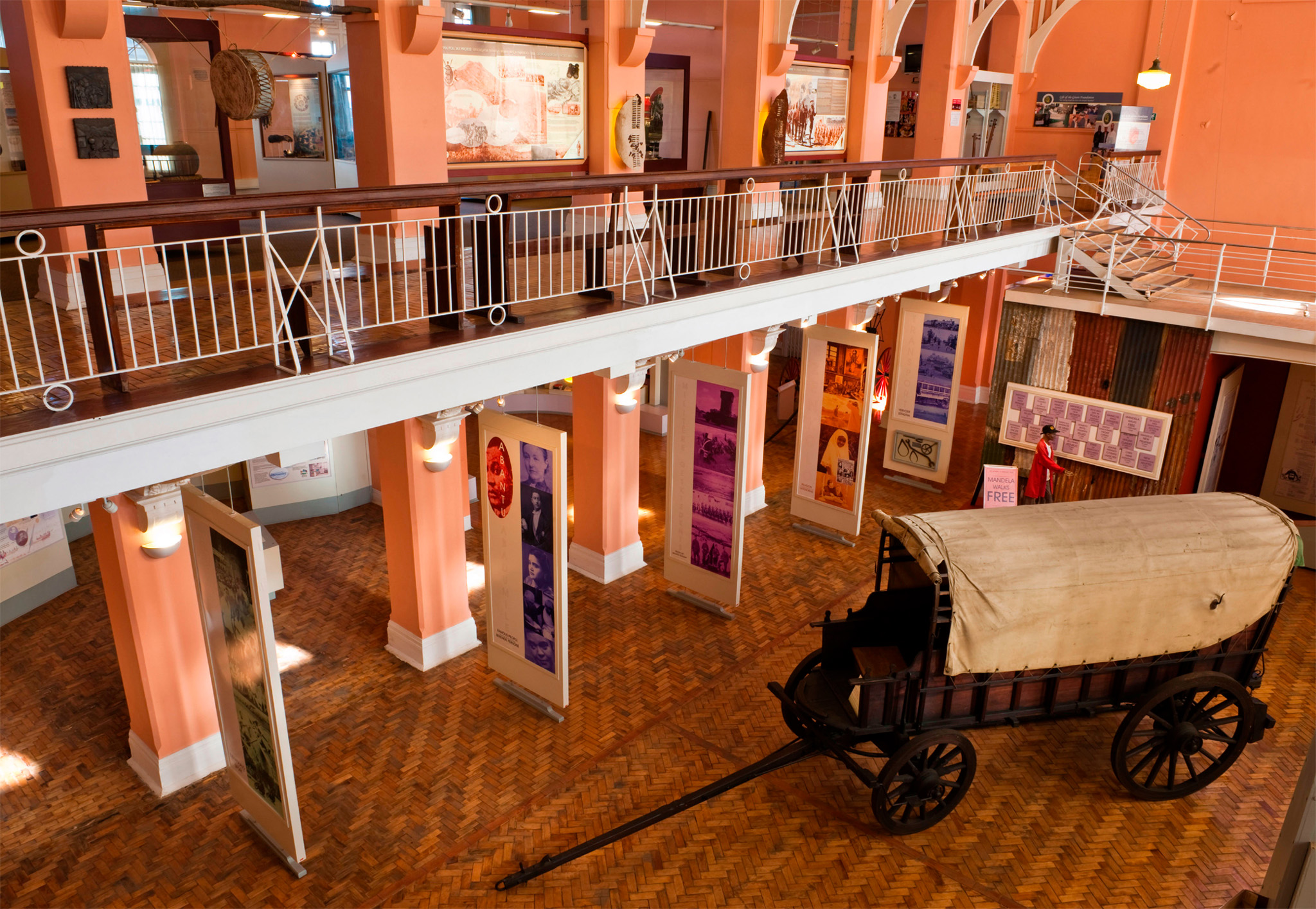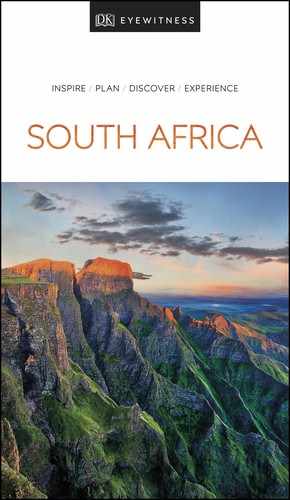Experience More
In a region where population densities are high and sugar cane plantations and coastal resorts have replaced most of the natural vegetation, this impressive ravine carved by the Umzimkulwana River is a delight for nature lovers.
There is a scenic circular drive, as well as walking trails with many beautiful picnic spots along the river and at viewpoints overlooking the waterfalls in the gorge.
Small, forest-dwelling animals such as bushbuck, duiker and samango monkey occur in the dense forest while the cliffs provide nesting sites for birds of prey.

t Visitors crossing the suspension bridge that cuts through Oribi Gorge
SARDINE RUN
Lying approximately 120 km (75 miles) south of Durban, the Hibiscus coastline is home to the famous “Sardine Run”. Each June or July, over several weeks, millions of the tiny fish head north from their Eastern Cape spawning grounds to the waters of Port Edward. They are dogged by predators such as dolphins, sharks and seals, while seabirds rain down from above to take their fill.
Port Edward, situated on the Umtamvuna River, is the southernmost beachside resort in KwaZulu-Natal. It is popular for swimming, fishing and boating. Established in 1925, the resort was named in honour of the Prince of Wales, later King Edward VIII. A casino resort, the Wild Coast Sun, was built here in 1981 to lure visitors from Durban and the South Coast. Today, it overlooks an unspoiled coastline covered in dense forest and grassland, and offers one of the country’s top golf courses.
The Mzamba Village Market opposite the resort’s main entrance sells a varied range of local crafts.
Did You Know?
Port Edward is home to the wreck of the Sao João, a treasure-laden Portuguese ship that sank in 1552.
Protecting a 30-km (19-mile) stretch of the Umtamvuna River as it flows through a deep forested gorge on the Eastern Cape border, this scenic reserve can be explored through a network of steep but well-marked walking trails, ranging in duration from three to eight hours. Large mammals such as bushbuck, chacma baboon, samango monkey and even leopard are present but mostly seldom seen. The mountainous scenery, dense subtropical forest, wealth of native plants and tranquil atmosphere, however, more than compensate. Birdlife in the area includes African finfoot, Knysna loerie, gorgeous bush-shrike and Gurney's sugarbird. Sadly, the reserve’s much-touted breeding colony of endangered Cape vulture has abandoned its cliffside roost for reasons that are unclear.
Named after the prominent colonial administrator Sir Theophilus Shepstone, the largest town on the KwaZulu-Natal South Coast was founded in 1867 to exploit the plentiful white granite deposits at the mouth of the Umzimkulu River. It has a pivotal location at the junction of the N2 and the coastal R61, but tourism development is focused 3 km (2 miles) further south at the fast-growing resort town of Shelly Beach. Offering great swimming conditions, this popular beach – actually a sandy strand, but named for the many shells that wash ashore here – has several tidal pools and lagoons for snorkelling and diving.

t The rocky coastline of Margate, a popular holiday destination
Self-proclaimed tourist capital of the South Coast, Margate comprises a broad expanse of golden sand hemmed in by well-tended, palm-shaded lawns and overlooked by a row of multi-storey hotels and holiday apartments.
Seaside activities include paddling pools, a freshwater swimming pool, water slides, mini-golf and there are plenty of amenities such as restaurants, ice-cream parlours and tackle shops. Designated surfing and boogie-boarding areas are on Main Beach and at Lucien Point. For a change of pace, try the two-hour walking trail through the diverse habitats of the Uvongo River Nature Reserve, home to a rich variety of birdlife.
experience KwaZulu-Natal
|
STAY The Estuary Hotel & Spa Set in a handsome manor house, this mid-sized hotel is a short walk from the beach. ⌂ Main Rd, Port Edward ∑ estuaryhotel.co.za Emerald Cove Head here to stay in an attractive thatched chalet, with good amenities and a sea-front location. ⌂ 1286 Marine Rd, Shelly Beach ∑ emeraldcove.co.za The Oyster Box An elegant 1930s icon. Located right on the beach, this Art Deco hotel boasts an infinity pool and a renowned high tea service. ⌂ 2 Lighthouse Rd, Umhlanga Rocks ∑ oysterboxhotel.com |
Just before it empties into the sea, the iVungu River plunges down a 23-m (75-ft) waterfall into a lagoon. High cliffs, overgrown with wild bananas, protect the sheltered lagoon with its spit of sandy beach separating the river from the ocean. It is a popular swimming spot, and pedal boats can be hired to explore the upper reaches of the river.
There are also walking trails in the River Valley Nature Reserve, which falls on both sides of the river. A two-hour circular walk winds through beautiful coastal forest full of a wide variety of indigenous plants and plentiful birdlife.
experience KwaZulu-Natal
|
EAT Enzo Pizzeria A family-run trattoria with great value pasta and pizzas. ⌂ 129 Marine Terrace, Scottburgh ∑ enzopizzeria.co.za Ile Maurice French-Mauritian specialities and a strong wine list. ⌂ 9 McCausland Crescent, Umhlanga Rocks ∑ ilemauricerestaurant.co.za MO-ZAM-BIK Head here for tasty Portuguese dishes. ⌂ 4 Boulevard Centre, Ballito ∑ mozambik.co.za |
An almost continuous carpet of sugar cane plantations lines this stretch of the South Coast, and the town of Scottburgh was once used as a harbour for exporting the crop. Today, the compact little town has a distinct holiday atmosphere, and is a popular beach resort. It occupies the prominent headland overlooking the mouth of the Mpambanyoni River, and most of the hotels and holiday apartments offer superb sea views.
In the 19th century, a spring used to cascade from the bank above the river, but today a large water slide occupies the site. A restaurant, shops, a miniature railway and tidal pool are added attractions. Further south, a caravan park adjoins the beach and there is also a popular golf course, with a prime site overlooking the Indian Ocean surf.
It is claimed that Amanzimtoti derives its name from a remark made by Shaka Zulu. In the 1820s, returning home from a campaign further down the South Coast, Shaka drank from a refreshing stream and is said to have exclaimed, “amanzi umtoti” (the water is sweet). Today, Amanzimtoti is a lively coastal resort. Its warm-water beaches are lined with hotels, holiday apartments, take-away outlets, restaurants and vibrant beachwear shops.
The area’s most popular beach extends for 3 km (2 miles) north of the Manzimtoti River and offers safe bathing, picnic sites and a fine salt-water pool.
The N2 passes within 400 m (400 yrds) of the coast, providing easy access to the town’s other attractions. These include a small bird sanctuary, a nature reserve and two fine golf courses in the vicinity of the beach.

t A photographer setting up his equipment at sunrise, on the rock-strewn sands of a beach in Umhlanga
Now a suburb of Durban, modern development lines the ridge above Umhlanga and includes shopping malls and business parks. But the town retains its atmosphere as the premier holiday resort on the North Coast and has excellent beaches, timeshare resorts, hotels and restaurants. The promenade, which extends for 3 km (2 miles), provides stunning views of the golden sands that have made Umhlanga famous. A local landmark is the red-and-white Umhlanga Lighthouse, located in front of the Oyster Box hotel.
Further north, at the mouth of the Ohlanga River, forested dunes form part of a nature reserve. A boardwalk crosses the river and the forest teems with blue duiker, birds and acrobatic monkeys.
Ballito and the neighbouring Salt Rock extend for 6 km (4 miles) along a coast known for its beaches, rocky headlands and sheltered tidal pools. Lining the main coastal road are many good restaurants. Accommodation ranges from luxury holiday apartments and timeshare resorts to family hotels and attractive caravan parks.
experience KwaZulu-Natal
Sharks on the Indian Ocean Coast

The warm waters off KwaZulu-Natal are favoured by 12–14 types of shark, including the great white, Zambezi (or bull), ragged-tooth (or sand tiger) and hammerhead. The harmless whale shark also visits this coast in summer. Major beaches in the area are protected by shark nets beyond the surf. These are maintained by the KZN Sharks Board, which finds about 1,200 sharks in the nets each year.

t Zulu dancers performing a traditional display in the village
For the 1984 TV series Shaka Zulu, several authentic 19th-century Zulu kraals were constructed. They were destroyed when filming finished, but that of Shaka’s father was spared and opened to the public as Shakaland.
The unique Zulu village is open for day visits, and also offers overnight accommodation at the Shakaland Hotel. A video explaining the origin of the Zulu people is shown, and guests enjoy Zulu fare, followed by a traditional dancing display.
On a tour of the 40-hut village, visitors are introduced to a variety of traditional skills such as hut-building, spear-making, beer-brewing, artistic beadwork and pottery.
Framed by thorn trees and aloes, Goedertrou Dam in the valley below is an attractive body of water. The sunset river boat cruises are an added attraction. In the hills east of Shakaland, and commanding a superb view over the wide Mhlatuze Valley, is the site of Shaka’s famed military stronghold, KwaBulawayo. Construction of this historic facility began in 1823, but today almost nothing remains of the citadel that once held so much of southern Africa in its grasp.

t Shakaland
Traditional Muthi Healing
A key aspect of Zulu culture is muthi (traditional medicine). Historically, it was practised by a male inyanga (herbalist), who concentrated on medicinal cures, and a female isangoma (diviner), who possessed psychic powers and the ability to communicate with the ancestral spirits, but today this division is less strict. Muthi is an assortment of medicine and remedies made from indigenous plant life. Animal products such as fat, claws, teeth and skin are also often used. Faith in traditional healing methods is still widespread and, in order to meet the demand for the plants, special “muthi gardens” have been established in a number of nature reserves.

t Visitors wandering the boardwalk in Dlinza Forest Nature Reserve, just outside Eshowe
Perched at an altitude of 520 m (1700 ft), Eshowe is an attractive small town whose misty midland climate feels especially invigorating after the sticky coast. The oldest town in Zululand, Eshowe has a significant place in the region’s history. It was the birthplace of King Cetshwayo c 1825, and served as a British military and administrative outpost in the aftermath of the 1879 Anglo-Zulu War.
Bordering the town centre, the 3-sq-km (1-sq-mile) Dlinza Forest Reserve protects a stand of mist-belt forest inhabited by the diminutive blue duiker and 90 bird species, notably crowned eagle, trumpeter hornbill, and the globally threatened spotted ground-thrush. An aerial boardwalk through the forest terminates at a 20-m- (66-ft-) high tower, which offers views to the Indian Ocean. Fort Nongqai, built by the British in a forest clearing in 1883, now houses the Vukani Museum’s peerless collection of Zulu ethnographic artifacts, as well as an outdoor dome showcasing some of the 85 butterfly species occurring in Dlinza.
"
Vukani Museum
⌂ 7 Nonggai Rd § 035 474 5274 # 7:30am–4pm Mon–Fri, 10am–4pm Sat, Sun & public hols
The underrated Umlalazi Nature Reserve packs a huge amount of biodiversity into its 10 sq km (4 sq miles). A short circular walking trail leads through South Africa’s most accessible mangrove swamp, home to mudskippers, hermit crabs and the gorgeous mangrove kingfisher.
A second walk leads through the dune forest to a wide, sandy beach and reveals glimpses of fish eagles and kingfishers. Shy forest animals such as vervet monkeys, red duiker and bushbuck can often be spotted.
The reserve is entered through the pretty hillside village of Mtunzini, whose name means “in the shade”. Its streets are lined with coral trees and in winter their red flowers add splashes of colour to the townscape. Mtunzini is well-known for its grove of raffia palms;the nearest other known group of these scarce plants is on the Mozambique border, 260 km (163 miles) north. The palms have been designated a National Moniment, and can be seen with the swamp forest from a raised boardwalk. The rare palm-nut vulture, a fruit-eating raptor, may also be spotted here.
experience KwaZulu-Natal
|
STAY George Hotel Established in 1906 and located adjacent to Dlinza Forest Reserve, this characterful hotel has an on-site craft brewery and offers a selection of local tours. ⌂ 36 Main St, Eshowe ∑ thegeorge.co.za Shakaland Hotel This perenially popular overnight stop offers a great cultural and dining experience, plus luxury accommodation in beehive huts. ⌂ R66 ∑ aha.co.za/shakaland |
experience KwaZulu-Natal
ZULU CULTURE
The Zulu people’s reputation for being a fierce warrior nation, fuelled by written accounts of the 1879 Anglo-Zulu War, has been enhanced by dramatic films such as Zulu and the internationally acclaimed television series Shaka Zulu. Many sites associated with Zulu history can be visited in the Ulundi, Eshowe and Melmoth districts of KwaZulu-Natal. It is true that the Zulu fought determinedly to defend their land, but their culture also encompasses arts and crafts including beadwork, pottery, basketry and dancing.
THE ZULU KRAAL

t A typical Zulu kraal, composed of beehive-shaped grass huts
Historically, the umuzi (Zulu kraal) was a circular settlement that enclosed several uhlongwa, beehive-shaped huts made with grass or rushes. Similar-style huts were used as grain stores, which were built on long stilts to protect them from birds and rodents. These structures were grouped around an enclosure in which the cattle – an important symbol of wealth in Zulu society – were corralled at night. Although the principle of the kraal continues, traditional architectural styles are seldom seen nowadays. Cement, bricks, concrete blocks and corrugated iron sheeting are the modern choices.
TRADITIONAL WEAPONS

t A woman preparing utshwala (beer), brewed from fermented maize and sorghum
Befitting the Zulus’ fearsome reputation, weaponry is an integral part of Zulu culture – even today, men often carry wooden staffs and clubs. At political meetings and rallies, tempers tend to flare, and as a result the carrying of traditional weapons has been outlawed by the government.
TRADITIONAL DANCING

t A group of dancers in traditional attire performing a dance known as the Ingoma
In Zulu society, social gatherings almost always involve dancing. Most Zulu dances require a high level of fitness – and a lack of inhibition. While ceremonial dances can involve large crowds of gyrating, clapping and stamping performers, small groups of performers need only the encouragement of an accompanying drum and singing, whistling or wailing onlookers. Lore and clan traditions may be related through the dance; alternatively, the movements may serve as a means of social commentary. The distinctive sound of a capella choral singing that accompanies the performances has become one of South Africa’s best-known cultural exports.
experience KwaZulu-Natal
ZULU CRAFTS

The Zulu people are renowned for their weaving. Most baskets display the traditional triangle or diamond shape, a symbol representing the male and female elements. Glass beads introduced by the early 19th-century traders created a new custom, and today, beadwork forms an important part of Zulu culture. Every pattern and colour has symbolic significance, as shown in the incwadi, or love letters, that are made by young women and given to eligible men.

t Giraffes roaming the gold-hued landscape of Ithala Game Reserve
From the unhurried village of Louwsburg on the R69, a tarred road descends an escarpment to the wilderness of Ithala, a 296-sq-km (114-sq-mile) tract of grassland with dramatic mountain scenery and densely wooded valleys.
The reserve was established in 1972 from previous farmland and since then it has been stocked with large species of game and has reverted back to its natural state. The Pongolo River flows along the northern boundary for some 37 km (23 miles). Seven tributaries have carved the deep valleys that dissect this park and enhance its scenic splendour. The Ngoje escarpment rises dramatically to 1,446 m (4,700 ft), providing a striking backdrop.
A tarred road also leads from the entrance to the prestigious Ntshondwe Camp. Its 67 chalets have been carefully nestled between boulders and wild fig trees. The central complex contains a reception area, restaurant, store and coffee shop, and offers panoramic views over the entire reserve. In front of the building an extensive wooden platform overlooks a reed-fringed waterhole, and is perfect for bird-watching. As no fences surround the camp, animals such as warthog often wander between the chalets. A path leads to a swimming pool tucked into a clearing at the base of the mountain.
Lavish Ntshondwe Lodge is a three-bedroomed hilltop cabin. The far-reaching vista from its deck and sunken swimming pool is arguably Ithala’s finest.
Game-viewing at Ithala is excellent. Visitors will see white rhino, hartebeest, kudu, giraffe, eland, impala, wildebeest, warthog and zebra, as well as the only population in KwaZulu-Natal of the rare tsessebe antelope. Elephant, buffalo, leopard and black rhino are also present, but are more difficult to locate.
Ngubhu Loop is the best drive in the park. Another route winds down the thickly wooded Dakaneni Valley to the Pongolo River. Although game is not as plentiful here as on the higher grasslands, the scenery is spectacular.
Did You Know?
The amount of methane gas produced daily by an elephant could power a car for 30 km (20 miles).

t The cosy lounge of the Homestead lodge in Phinda Game Reserve
Extending over 170 sq km (65 sq miles) of bushveld, wetland, savannah and sand forest, the privately owned Phinda is sandwiched between the iSimangaliso Wetland Park and uMkhuze Game Reserve. It was established by &Beyond in 1991, a company that aims to create sustainable conservation through responsible luxury tourism. Similar wildlife to that seen at uMkhuze can be spotted, such as nyala, kudu, wildebeest, giraffe, zebra, elephant, lion, white rhino and cheetah. Activities on offer include sunset cruises on the Mzinene River and outdoor dining, as well as game-viewing drives, bush walks and fishing or diving expeditions. There are six lodges, each with its own unique atmosphere and bush or wetland views. The reserve can arrange air and road transfers.
This large wilderness reserve bordering Mozambique protects the flood plain of the Pongolo River. It was established in 1983 to conserve the elephants that migrate between the two countries. The park also has South Africa’s largest population of suni antelopes and 430 species of birds. There is a tented camp near the entrance, and two hides overlook areas where elephants come to drink. Additionally, ten groups of day visitors are permitted (in 4WD vehicles only).
West of Tembe, the Ndumo Game Reserve is famous for its rich riverine life, especially waterbirds. The Nyamithi and Banzi pans also sustain populations of hippo, crocodile and white and black rhino.
" ' =
Ndumo Game Reserve
§ 035 591 0098 # Apr–Sep: 6am–6pm daily; Oct–Mar: 5am–7pm daily
experience KwaZulu-Natal
|
STAY Zululand Tree Lodge Well located for self-drive exploration of northern KwaZulu-Natal, these stilted houses stand in a small private reserve that supports giraffe, rhino, various antelope and 400-plus bird species. ⌂ Ubizane Wildlife Reserve ∑ ubizane.co.za &Beyond Phinda Mountain Lodge Of the four magnificent lodges set in KwaZulu-Natal’s most exclusive Big Five destination, Mountain Lodge is the largest and – though not exactly cheap –the most affordable. ⌂ Phinda Private Game Reserve ∑ andbeyond.com |
The undulating hills of the KwaZulu-Natal Midlands, with their green patches of forest and their dairy farms, have long been a retreat favoured by artists and craftspeople. In 1985, six studios established an arts and crafts route as a means of boosting tourism: the Midlands Meander. The trail quickly gained popularity and now consists of around 400 members and studios.
There are five routes that meander between the small towns of Hilton, Nottingham Road, Howick and Mooi River. Locally crafted goods available to purchase along the route include herbs, cheese, wine, pottery, woven cloth, stained glass and antiques.
The symbol of the Midlands Meander seen on road signs marking the routes is the endangered Karkloof blue butterfly, indigenous to this region of KwaZulu-Natal.
Accommodation along the way includes idyllic country hotels, tranquil guest farms, picturesque lodges and cosy bed and breakfast establishments. There are also many quaint country pubs.
experience KwaZulu-Natal
|
Shop Mix craft shopping and foodie fun at these Midlands Meander stops. Karkloof Farmers Market Fresh produce market with a plant nursery and children’s activities. ⌂ Howick # 7–11am Sat ∑ karklooffarmersmarket.co.za The Junction A shopping village in green surrounds, offering healthy food and a candle dipping shop. ⌂ Nottingham Rd § 033 266 6116 Piggly Wiggly Country Village Picnickers will enjoy the superb deli; kids head straight for the miniature steam train (weekends only). ⌂ Lions River ∑ pigglywiggly.co.za |

t Interior of the Msunduzi Museum, one of Pietermaritzburg’s many cultural buildings
Since its humble establishment by Afrikaner farmers in 1836, Pietermaritzburg (part of the Msunduzi municipality) has developed into the commercial, industrial and administrative centre of the KwaZulu-Natal Midlands. An intriguing blend of Victorian, Indian, African and modern architecture and culture combine to produce a distinctly South African city. Many historical and cultural buildings and monuments are located around the city centre and in the western suburbs. In Church Street, a statue of Ghandi recalls the occasion in 1893 when the future Mahatma – then a 23-year old lawyer – was forced off a first-class train carriage here because he wasn’t white.
Visitors can ramble through the surrounding forests and botanic gardens, and visit several nature reserves and recreation resorts located within the city or a few minutes’ drive away.

t Water tumbling over steep cliffs in Howick
Established in 1850, the agreeable town of Howick overlooks an eponymous waterfall known to the local Zulu as KwaNogqaza (‘Tall One”). The bordering Midmar Dam Nature Reserve is popular as a venue for water sports enthusiasts and fishermen.
North of Howick, the Nelson Mandela Capture Site marks the spot where its namesake was arrested by security police, on 5 August 1962, with a striking sculpture of Mandela’s face. A visitor centre and exhibition opened in 2019.
Further afield, Karkloof Nature Reserve protects a mist-belt forest inhabited by samango monkey, an endemic dwarf chameleon species and a wealth of birds. It can be explored via a scenic walking trail or along zip-lines on the Karkloof Canopy Tour.
Nelson Mandela Capture Site

t Which are often tackled by rock climbers
This picturesque dam nestles at the foot of the 1,466-m- (4,810-ft-) high Spioenkop, which in 1900 was the scene of a decisive battle between the British and Boer forces in the South African War. The battlefield site is accessible from the road, and countless graves and memorials are scattered across the peak’s summit as a grim reminder of one of Britain’s worst defeats during that conflict.
Today, Spioenkop is popular with outdoor enthusiasts. The dam offers fishing and boating, while zebra, giraffe, wildebeest, red hartebeest and oribi can be seen in the surrounding nature reserve, along with a variety of bird species. There is also a pleasant campsite, and picnic sites are situated along the southern shoreline. Two short trails encourage visitors to view game on foot.
experience KwaZulu-Natal
The Hindu Population of KwaZulu-Natal

When the first sugar was produced from sugar cane in 1851, the Natal Colony required cheap labour to work in the plantations. Between 1860 and 1911, 152,000 indentured labourers were shipped to Durban from Madras and Calcutta in India. At the end of their five-year contracts, the workers were offered a free passage home. More than half opted to remain in South Africa, becoming active as retailers and farmers, and later in other industries. Of the current population of 900,000 (the largest Indian community outside Asia), an estimated 50 per cent are Hindu.
